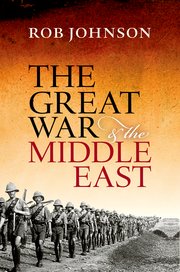There have been a number of publications on the various First World War Middle Eastern campaigns, but Johnson has, in examining the period from 1907 to 1923, brought every element involved in the Middle East during this period into a comprehensive and fascinating work.
Britain’s desire to maintain its influence in the Middle East and the measures taken in the years prior to WWI to achieve this laid the foundation for what subsequently followed. The players were many and varied – and how their strategies, resistance and reactions constantly changed during the period of conflict.

Hardback 400pp RRP: $50.95
External influences such as the priority given to the battle on the Western Front, and the collapse of the Russian army with the Bolshevik Revolution in 1917 had a profound influence on policy, strategy and military tactics. The Ottoman Empire’s failure to generate a pan-Islamic resistance (jihad) to British Empire subjects, Germany’s subversive activities, the Ottoman’s secret plans to annihilate Armenians and the Arab Revolt of 1916-17 are all interwoven into this most complicated theatre of war. There was manoeuvring by all parties to place themselves in the most advantageous position when an armistice would be signed.
The individual campaigns and key personnel involved have not been ignored. The Gallipoli Peninsula, the protection of the Suez Canal, the push into the Sinai, the defeat of the British at Kut, the capture of Gaza and Jerusalem as well as the Arab Revolt of 1916-17 and the battles the Ottoman armies fought against the Russians in the Caucasus at tremendous manpower cost have all been described in detail. Johnson has most effectively intertwined the military, strategic and political aspects involved. Examination has been made of the peacemaking process and the negotiations involved from 1919 to 1923 that produced the fractured Middle East that has seen 100 years of subsequent political instability. The Epilogue contains brief biological notes on the main WWI Middle Eastern political and military players.
This most detailed study has made use of a myriad of sources as is attested by the copious Endnotes, Bibliography and Index. Seven maps of the period enable the reader to follow events across a region that, apart from cities, does not conform to the 21st Century boundaries. A generous number of photographs have been included.
A very readable ‘single volume’ for any military history buff to gain an excellent overall picture of what most definitely was not a ‘minor sideshow’ to the Western Front.
Reviewed for RUSIV by Neville Taylor, September 2017
Contact Royal United Services Institute about this article.






